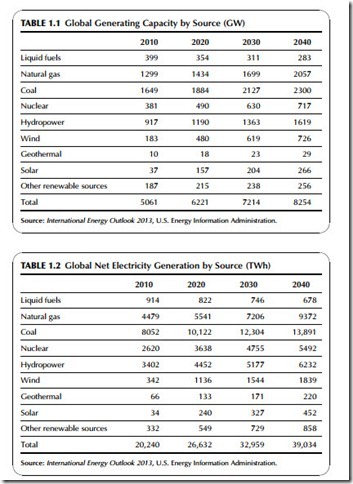SIZE OF THE INDUSTRY
How big is the global electricity industry? Tables 1.1 and 1.2 provide the answer, at least as far as power generation is concerned. Table 1.1 shows the global generating capacity in 2010 broken down by power station type together with projections for the sizes in 2020, 2030, and 2040.
Total global generating capacity in 2010 was 5061 GW. Based on the pre- dictions contained in Table 1.1, this capacity will rise to 6221 GW in 2020, 7214 GW in 2030, and 8254 GW in 2040. This is more than twice the capacity in
Source: International Energy Outlook 2013, U.S. Energy Information Administration.
2000, which stood at 3366 GW. These predictions depend on a number of assumptions about the way in which the industry will develop and, in particular, how active governments are promoting renewable energy. Growth could plau- sibly be either slower or faster but the figures in Table 1.1 offer a median projection.
When the figures are broken down by the type of generating station or energy source, coal can be seen to be the largest provider of power in terms of generating capacity, accounting for just under 33% of the global total. This continues to be the case in the predictions for future years shown. Natural gas is the second most important energy provider, followed by hydropower. Between them, these three accounted for 76% of global capacity in 2010. This is predicted to fall to 72% by 2040.
Aside from hydropower, wind and solar power are considered the most important renewable sources today, and these are the generating technologies that are showing the most rapid growth in global capacity. Both are expected to show strong growth during the period covered by Table 1.1, and it is possible that the actual growth, particularly for solar power, could outstrip these predictions.
A regional breakdown of capacity and capacity growth from the same source as these figures shows that the fastest growth in generating capacity is taking place among developing countries where average annual growth is expected to be 2.3% between 2010 and 2040. Within developed countries, on the other hand, the predicted rate of growth, at 0.9%, is notably slower.
Table 1.2 shows parallel figures to those shown in Table 1.1 but for global net electricity generation, broken down by type. The total amount of electricity generated in 2010 was 20,240 TWh. As before the table contains predictions for the production level in 2020, 2030, and 2040. These figures show that production is expected to virtually double between 2010 and 2040, when it is predicted to reach 39,034 GWh. This is 167% more than the net generation in 2000, when global output stood at 14,618 TWh.
As might be expected from Table 1.1, the most important global source of electricity is coal, which provided 8052 TWh in 2010, or just under 40% of the total. This is expected to decline to 35% by 2040, but it will remain the single most important source of electricity based on these predictions. Natural gas is the second largest source in 2010, providing 4479 TWh or 22% of the total. Hydropower is the third most significant source with 17% of the total. Once again these three supply the bulk of the global electricity supply—79% of the total in 2010.
It is notable, when comparing Tables 1.1 and 1.2, that while nuclear generating capacity accounted for only 8% of total generating capacity in 2010, it actually supplied 13% of total output, proportionally much larger than the con- tribution from hydropower. This is a reflection of the fact that while nuclear power plants generally operate as baseoad power stations, generating at close to full power for most of the time, hydropower plants provide a variable output depending on the season. It is also becoming increasingly common for hydro- power plants to be used for grid support, providing power when other sources cannot. This means that they often provide less power than they are technically capable of supplying.
The output from both solar and wind power plants is also lower than that from fossil fuel and nuclear power plants of similar generating capacity. This is because the energy sources—that is, the wind and sun—are intermittent and do not provide energy all the time. While a coal-fired power plant or a nuclear power plant may be able to generate power for 80–90% of the time, a wind plant will be performing well if it can generate the equivalent of full power for 40% of the time.
While the figures in the Tables 1.1 and 1.2 provide a broad picture of production and capacity globally, there are important regional differences that they cannot convey. These differences are a reflection of the resources available in different parts of the world. For example, many South American countries rely heavily on hydropower, whereas the main industrial nations in Asia, China, and India are heavily dependent on coal power. The United States also provides a large part of its electricity from coal. In contrast, coal use in Europe is much lower, and this region as a whole has the largest new renewable generating capacity, mainly wind and solar power. (Hydropower is considered an old renewable technology.)
The electricity industry is large and it is also conservative. Change is generally slow and takes place over generations. Most power stations have a life- time of 30 years, some much longer, and capacity is only replaced when it is exhausted. Nevertheless, the composition of the world’s generating capacity will not remain static and new technologies will gradually displace older ones. If the 20th century was the century when coal and hydropower dominated, the 21st century can be expected to see much more renewable generation. Even so, as Table 1.2 shows, coal and hydropower will remain important well into the century.
